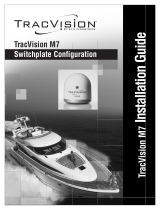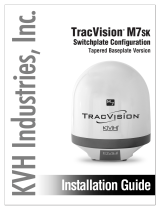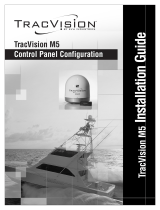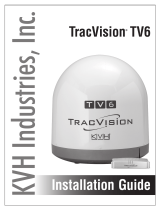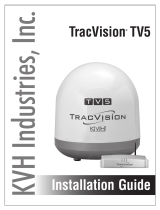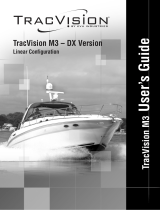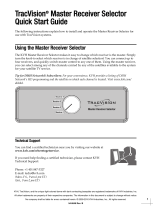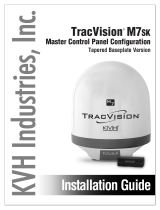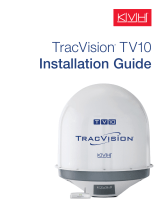Page is loading ...

TracVision M5 Installation Guide
TracVision M5
Switchplate Configuration

TracVision M5 Installation Guide
1
Switchplate Configuration
KVH, TracVision, and the unique light-colored dome with contrasting baseplate are registered trademarks of KVH Industries, Inc.
All other trademarks are property of their respective companies. The information in this document is subject to change without notice.
No company shall be liable for errors contained herein. © 2007 KVH Industries, Inc., All rights reserved. 54-0416 Rev. A
These instructions explain how to install the TracVision M5 satellite TV antenna system on a
vessel. Complete instructions on how to use the system are provided in the User’s Guide.
Installation Steps
Who Should Install the System?
To ensure a safe and effective installation, KVH recommends that a KVH-authorized marine
technician install the TracVision antenna. KVH-authorized technicians have the tools and
electronics expertise necessary to install the system. To find a technician near you, visit
www.kvh.com/wheretogetservice.
Linear vs. Circular Systems
The installation process differs slightly depending on the type of LNB (low noise block) that is
installed in the antenna (linear or circular). These differences are noted throughout this manual.
Appendix B on page 22 notes the type of LNB required for each region and satellite.
Technical Support
If you need technical assistance, please contact KVH Technical Support:
1. Inspect Parts and Get Tools, 3
2. Plan the Antenna Installation, 4
3. Plan the Switchplate Installation, 5
4. Prepare the Antenna Site, 6
5. Remove the Restraints, 7
6. Wire the Antenna, 8
7. Mount the Antenna, 9
8. Wire the Switchplate, 10
9. Wire the Receiver(s), 11
10. Connect Power, 12
11. Mount the Switchplate, 13
12. Enter Your Latitude & Longitude, 14
13. Select Satellites, 16
14. Set the LNB Skew Angle (Linear only), 17
15. Educate the Customer, 18
North/South America, Australia:
Phone: +1 401 847-3327
E-mail: [email protected]
Europe, Middle East, Asia:
Phone: +45 45 160 180
E-mail: [email protected]

3
Before you begin, follow these steps to make sure
you have everything you need to complete the
installation.
a. Unpack the box and ensure it contains
everything shown on the Kitpack Contents
List. Save the packaging for future use.
b. Carefully examine all of the supplied parts to
ensure nothing was damaged in shipment.
c. Gather all of the tools and materials listed
below. You will need these items to complete
the installation.
• Flat-head and Phillips-head screwdrivers
• Electric drill and 3/8" (10 mm), 5/32"
(4 mm), and 3/32" (2.25 mm) drill bits
• 3" (80 mm) hole saw
• Socket wrenches
• 7/16" open-end wrench
• Light hammer and center punch
• Adhesive tape and scriber or pencil
• Wire strippers and terminal lug crimper
• RG-6 or RG-11 RF coax cable(s) with
Snap-N-Seal® F-connectors (see Figure 2);
see Step 6a on page 8 to determine the
number of cables required
• Connector installation tool (Augat IT1000
- KVH part #19-0242)
• Power cable (see Figure 3)
• Satellite TV receiver and TV
• Windows® laptop PC with Windows
HyperTerminal or KVH Flash Update
Wizard installed
Radome
Baseplate
Figure 1: TracVision M5 System Components
Antenna
Switchplate
Always lift the antenna by the baseplate and
never by the radome or any portion of the
internal antenna assembly (see Figure 1).
IMPORTANT!
Figure 2: RF Cable Guidelines
Cable Length Use Cable Type
<= 75 ft (23 m) RG-6
> 75 ft (23 m) RG-11
Figure 3: Power Cable Guidelines
Cable Length Use Cable Gauge
< 40 ft (12 m)
14AWG (2.5mm
2
)
40-70 ft (12-21 m)
12AWG (4mm
2
)
Inspect Parts and Get Tools
1

4
Before you begin, consider the following antenna
installation guidelines:
• Minimize blockage. The antenna requires a
clear view of the sky to receive satellite TV
(see Figure 4). The fewer obstructions, the
better the system will perform.
• Make sure the mounting surface is wide
enough to accommodate the antenna’s base
(see Figure 5). Also make sure it is flat, level,
strong enough to support the antenna’s
weight (30 lbs, 13.6 kg), and rigid enough to
withstand vibration.
• Select a location that is as close as possible to
the intersection of the vessel’s fore-and-aft
centerline and midships.
• Do not mount the antenna at the same level
as the radar because the radar’s energy might
overload the antenna. Ideally, you should
mount the antenna 4 ft (1.2 m) above and 4 ft
(1.2 m) away from the radar.
Blocked!
TracVision Antenna
Mast
Look Angle
Vessel Platform
Figure 4: Blockage from Obstruction
21"
(54 cm)
19.3"
(49 cm)
9"
(22.9 cm)
9"
(23 cm)
4.5"
(11.4 cm)
4.5"
(11.4 cm)
4 x 5/16"
( 8 mm)
19.3"
(49 cm)
Figure 5: Antenna Dimensions
Side View
Bottom View
Plan the Antenna Installation
2

5
Before you begin, consider the following
switchplate installation guidelines:
• Select a switchplate mounting location in a
dry, well-ventilated area belowdecks away
from any heat sources or salt spray.
• Be sure to leave enough room at the
switchplate’s rear panel for connecting the
cables (see Figure 6 for switchplate
dimensions).
• Since the supplied data cable is 50 ft (15 m)
long, the switchplate must be located within
50 ft (15 m) of the antenna.
Prepare the Switchplate Mounting Site
Once you have identified a suitable switchplate
mounting site, follow these steps to prepare the
site for installation.
a. Using the switchplate mounting template
provided at the end of this manual, mark and
cut out a hole in the mounting surface to
accommodate the switchplate (see Figure 7).
b. Using the same template, mark the locations
for the four switchplate mounting holes.
c. Drill a 3/32" (2.25 mm) hole at the four
mounting hole locations. Later, you will
mount the switchplate using four #6 screws.
2.96"
(75.2 mm)
4.39"
(111.5 mm)
Figure 6: Switchplate Dimensions
3/32" ( 2.25 mm)
Mounting Hole (x4)
3.82"
(97 mm)
.32" (8 mm)
2.36"
(60 mm)
.16" (4 mm)
3.19"
(81 mm)
2.05"
(52 mm)
Panel Cutout
Figure 7: Switchplate Mounting Holes Layout
Plan the Switchplate Installation
3

6
Once you have identified a suitable antenna
mounting site, according to the guidelines
provided in Step 2, follow these steps to drill the
mounting holes and cable access hole to prepare
the site for installation.
a. Unfold the antenna mounting template
(supplied in the Customer Welcome Kit) and
place it onto the mounting surface. Make sure
the “FWD” (forward) arrow points toward
the bow and is parallel to the vessel’s
centerline (see Figure 8).
NOTE: You don’t need to mount the antenna
exactly on the vessel’s centerline, but the
antenna’s forward arrow must be parallel to it.
b. Use the template to mark the locations for the
four mounting holes and cable access hole on
the mounting surface.
c. Drill a 3/8" (10 mm) hole at the four
mounting hole locations you marked in
Step 4b. Later, you will insert four 1/4"-20
bolts through these holes to secure the
antenna to the mounting surface.
d. Cut out the 3" (80 mm) cable access hole in
the location you marked in Step 4b. Smooth
the edges of the hole to protect the cables.
Later, you will route the data, power, and RF
cables through this hole and into the vessel.
e. Clean and dry the antenna mounting surface.
f. Peel off the paper backing from the supplied
foam seal to expose the adhesive. Then press
the foam seal down firmly onto the mounting
surface, ensuring the narrow end points
toward the bow and the hole in the foam seal
aligns with the cable access hole in the
mounting surface (see Figure 9).
9"
(229 mm)
FWD
3/8" ( 10 mm)
Mounting Hole (x4)
9"
(229 mm)
3" ( 80 mm)
Cable Access Hole
Figure 8: Antenna Mounting Holes Layout
Figure 9: Foam Seal
Bow
Align with
Cable Access Hole
Prepare the Antenna Site
4

7
Inside the antenna, a foam block and two bolts
prevent the antenna assembly from moving
during shipment. Follow these steps to remove
these shipping restraints.
a. Remove the three #10-24 Phillips screws
securing the radome to the baseplate.
Carefully lift the radome straight up until
clear of the antenna assembly and set it aside
in a safe place.
TIP: If you keep the radome topside, secure it with
a lanyard to prevent it from falling overboard.
b. Remove the foam block that is wedged
beneath the antenna’s reflector (see
Figure 10). Save this restraint for future use;
the customer will need to reinstall it if he/she
needs to relocate or reship the antenna.
c. Using a 10 mm socket wrench, remove the
two bolts, washers, and spacers securing the
antenna assembly to the baseplate (see
Figure 11 and Figure 12). Save these restraints
for future use.
Figure 10: Foam Block Shipping Restraint
Foam Block
Shipping Restraint
Washer
Spacer
Bolt
Figure 11: Shipping Restraint Hardware
Figure 12: Removing the Shipping Restraint Bolts
Once you have removed the restraints,
handle the antenna very carefully. With the
restraints removed, the internal antenna
assembly rotates freely and, if not handled
properly, can damage the limit switch.
IMPORTANT!
Remove the Restraints
5

8
Follow these steps to connect the data, power,
and RF cables to the antenna.
a. First determine the number of RF coax cables
required for your particular installation. If
you wish to connect just one satellite TV
receiver to the TracVision system, only one
RF cable is required. If you wish to connect
two or more receivers to the system, you
need two RF cables. (See Figure 13 to
determine the type of cable required.)
b. Route the data, power, and RF cables
belowdecks through the 3" (80 mm) cable
access hole. Leave an adequate service loop,
approximately 8" (20 cm) of slack, in the
cables for easy serviceability. Later, you will
connect the data and power cables to the
switchplate and the RF cable(s) to the
receiver(s).
c. Connect the data cable to the “Data” jack on
the bottom of the antenna (see Figure 14 and
Figure 15). Hand-tighten until the connector
locks in place; do not use excessive force.
d. Connect the power cable to the “Power” jack
on the bottom of the antenna. Hand-tighten
until the connector locks in place; do not use
excessive force.
e. Connect an RF coax cable to the “RF1” jack on
the bottom of the antenna. Hand-tighten,
then tighten with a 7/16" wrench for 1/4 turn
to ensure an electrical and weather-proof
connection.
f. If you wish to connect two or more receivers,
connect a second RF coax cable to the “RF2”
jack on the bottom of the antenna. Label both
RF cables to match the antenna connectors so
that you can easily identify the cables later.
Figure 13: RF Cable Guidelines
Cable Length Use Cable Type
<= 75 ft (23 m) RG-6
> 75 ft (23 m) RG-11
Figure 14: Connectors on Bottom of Antenna
RF1
RF2
Data
Power
Single Receiver
Installation
Second Receiver
Installation
Figure 15: Antenna Cable Connections
Wire the Antenna
6

9
Follow these steps to mount the antenna to the
mounting surface.
a. Place the antenna baseplate over the holes
drilled in the mounting surface. Ensure the
“Forward” arrow inside the baseplate points
toward the bow and is parallel to the vessel’s
centerline (see Figure 16).
b. Make sure the four holes in the baseplate line
up with the four holes in the mounting
surface.
c. At each of the four baseplate mounting holes,
place a 1/4" flat washer on a 1/4"-20 bolt and
insert the bolt into the hole from above (see
Figure 17).
d. Secure each mounting bolt to the mounting
surface using a 1/4" flat washer and a
1/4"-20 lock nut from below. Tighten all four
bolts until the four rubber feet are bottomed
against the mounting surface and the foam
seal is fully compressed.
TIP: If you are installing a linear system, you may
wish to keep the radome off for now. Later, you will
need to adjust the skew angle of the antenna’s LNB.
e. Reinstall the radome onto the antenna. Secure
in place with the three #10-24 screws you
removed in Step 5a (see Figure 18).
f. Install a protective plastic screw cap
(supplied in the kitpack) over each radome
screw.
Figure 16: “Forward” Arrow in Antenna Baseplate
You will need to rotate the antenna assembly
by hand to see all four mounting holes. Rotate
the antenna assembly slowly. If it hits a
mechanical stop with excessive force, the
limit switch might become damaged.
IMPORTANT!
1/4"-20 x 3" Bolt (x4)
1/4" Flat Washer (x4)
Foam Seal
Mounting Surface
1/4" Flat Washer (x4)
1/4"-20 Lock Nut (x4)
Antenna Base
Figure 17: Mounting the Antenna (Side View)
Figure 18: Installing the Radome
#10-24 Screws (x3)
Mount the Antenna
7

10
Follow these steps to connect the switchplate to
the antenna.
NOTE: System wiring diagrams are provided in
Appendix D on page 26.
a. First dress the data and power cables from
the antenna. Strip back the insulation of each
wire approximately 1/4" (6 mm) and gently
twist each wire to ensure a good electrical
connection.
b. Connect the data cable from the antenna to
the terminal board on the back of the
switchplate (see Figure 19). Be sure to match
the wire colors with the terminal board label.
Tighten the terminal screws to secure all
wires in place.
c. Connect the power cable from the antenna to
the switchplate’s power output terminals (see
Figure 20).
BLU/WHT Not Used
WHT/BLU Not Used
BRN/WHT PC GND
WHT/BRN PC TXD
ORG/WHT PC RXD
WHT/ORG RF GND
GRY/WHT RF RXD
WHT/GRY RF TXD
GRN/WHT Not Used
WHT/GRN Not Used
Data Cable
to Antenna
Figure 19: Switchplate Wiring - Antenna Data Cable
The diagram refers to wires by body color/
stripe color. For example, “Blue/White”
means the blue wire with the white stripe.
IMPORTANT!
Do not connect the data cable’s drain wire
(shield) to anything. You can simply snip it
from the cable.
IMPORTANT!
+
–
+12 VDC (Red)
Ground (Black)
To Antenna
Figure 20: Switchplate Wiring - Antenna Power Cable
Wire the Switchplate
8

11
In Step 6, you routed the RF coax cables from the
antenna, through the cable access hole, and into
the vessel. Follow these steps to connect the RF
coax cable(s) to the customer’s satellite TV
receiver(s).
a. If you are connecting two receivers to the
TracVision system, decide which receiver
will be the primary receiver. The primary
receiver controls satellite selection.
NOTE: The secondary receiver will only be able to
select a channel carried on the satellite that is
currently selected on the primary receiver.
b. Connect the RF1 cable from the antenna to
the “Satellite In” jack on the primary receiver
(see Figure 21).
c. If you are connecting two receivers, connect
the RF2 cable from the antenna to the
“Satellite In” jack on the secondary receiver.
d. Connect the receiver(s) to the customer’s
television(s). Follow the instructions in the
receiver’s manual.
If you wish to connect three or more receivers
to the antenna, see Appendix A on page 21.
IMPORTANT!
Antenna
SATELLITE IN
OUT TO TV
TV ANT/CABLE IN
AUDIO VIDEO S-VIDEO PHONE JACK
RL
SATELLITE IN
Secondary Receiver - Optional
Primary Receiver
SATELLITE IN
OUT TO TV
TV ANT/CABLE IN
AUDIO VIDEO S-VIDEO PHONE JACK
RL
SATELLITE IN
This receiver controls
satellite selection
RF1
RF2
Figure 21: Wiring the Receivers to the Antenna
Be sure all receivers are grounded. If the
receiver has a 2-prong power plug, run a
ground wire from the receiver’s chassis to a
suitable ground point. If a potential exists
between AC and DC grounds, connect the
wire to the switchplate’s DC return instead.
IMPORTANT!
Wire the Receiver(s)
9

12
Follow these steps to connect power. The
switchplate supplies power to the antenna.
a. Before you begin, disconnect vessel power.
b. Connect a power cable to 12 VDC vessel
power (for cable specifications, see Figure 3
on page 3).
c. Connect your vessel power wires to the
power (+) and ground (-) input terminals on
the switchplate (see Figure 22).
CAUTION
For your own safety, disconnect vessel power
and make sure the circuit is dead before you
connect any power wires.
Power supplied to the antenna must not fall
below 11 VDC or exceed 16 VDC.
IMPORTANT!
11-16 VDC
Ground
Vessel Power
+
–
Figure 22: Switchplate Wiring - Vessel Power Cable
Connect Power
10

13
In Step 3 on page 5, you identified a suitable
location for the switchplate and cut out the
mounting hole in the mounting surface. Now
follow these steps to mount the switchplate.
a. Fit the switchplate assembly into the
mounting hole until it is flush with the
mounting surface.
b. Drill four 5/32" (4 mm) holes in the
countersunk settings in the switchplate’s
support frame (see Figure 23).
c. Secure the support frame and switchplate
assembly to the mounting surface using four
#6 screws.
d. Snap the front cover onto the switchplate to
conceal the mounting screws and support
frame.
Switchplate
5/32" ( 4 mm)
Mounting Hole (x4)
#6 Screw (x4)
Front Cover
Mounting Surface
Figure 23: Mounting the Switchplate
Mount the Switchplate
11

14
Follow these steps to enter your vessel’s latitude
and longitude into the antenna.
NOTE: The antenna will use your position
information to speed up satellite acquisition. If the
antenna knows where you are, it knows where it
should start looking for the satellite (see Figure 24). In
addition, for a linear system, the antenna will use
your position information to calculate the correct LNB
skew angle.
Connect a Laptop to the Antenna
To enter data into the antenna, you first need to
connect a Windows® laptop computer to the
TracVision system and start Windows
HyperTerminal.
TIP: If you are a KVH-authorized technician, you can
use the KVH Flash Update Wizard instead of
HyperTerminal. Enter commands in the wizard’s
“Antenna Comms” window.
a. Using a straight PC serial data cable, connect
your laptop to the DB9 Maintenance port on
the front of the switchplate (see Figure 25).
NOTE: If your computer does not have a DB9 serial
COM port, you can use the USB-to-RS232 adapter
manufactured by IOGear (IOGear part number
GUC232A) or Belkin (Belkin part number F5U109).
b. Open Windows HyperTerminal and establish
the following settings for your COM port (see
Figure 26):
• Bits per second: 9600
• Data bits: 8
•Parity: None
• Stop bits: 1
•Flow control: None
TIP: To view characters on the screen as you type, set
up HyperTerminal to echo typed characters. Select
“Properties” from the File menu; select “ASCII
Setup” at the Settings tab; then select “Echo typed
characters locally” at the ASCII Setup window.
Figure 24: Direction to Satellite Depends on Your Location
Figure 25: Switchplate Front Panel
ON
OFF
Maintenance Port
Figure 26: HyperTerminal Settings
Maintenance Port
Enter Your Latitude & Longitude
12

15
c. Ensure the antenna has a clear, unobstructed
view of the sky.
d. Apply power to the satellite TV receiver(s)
and the switchplate (see Figure 25 on page
14). Wait two minutes for system startup.
e. Data should now be scrolling in your
HyperTerminal window (see Figure 27). If no
data appears, check your connections and
make sure you’re using the right COM port.
Enter Your Latitude and Longitude
To enter your position information into the
antenna, enter the following commands via
Windows HyperTerminal or KVH Flash Update
Wizard:
a. Type HALT then press Enter.
b. Type DEBUGON then press Enter.
c. Type the following command then press
Enter. Italics indicate a variable.
GPS,XX,A,YYY,B
XX = Latitude (0 - 90)
A = S (South) or N (North)
YYY = Longitude (0-180)
B = E (East) or W (West)
NOTE: Do not enter decimals. Simply round your
latitude and longitude to the nearest whole numbers.
Figure 27: Antenna Data Scrolling in Window
Entering a vessel position of 57°N, 22°E:
HALT
DEBUGON
GPS,57,N,22,E
EXAMPLE
Continued...
12

16
Follow these steps to set up the system for the
desired pair of satellites.
Enter the following commands via Windows
HyperTerminal or KVH Flash Update Wizard:
a. Type HALT then press Enter.
b. Type DEBUGON then press Enter.
c. Type the following command then press
Enter. Italics indicate a variable.
SATINSTALL,SatelliteA,SatelliteB
SatelliteA = Name of 1st desired satellite
SatelliteB = Name of 2nd desired satellite
See Appendix B on page 22 for a list of all
available satellites. Be sure to enter the
satellite names as they appear in the library.
NOTE: If you don’t find the satellite you want,
you can set up a user-defined satellite (USER 1 or
USER 2). See Appendix C on page 23.
d. Type @L,A then press Enter.
e. Type ZAP then press Enter. The antenna
restarts. Wait two minutes for system startup.
f. (Linear only) Set up the receiver(s) for the
same satellites, and in the same order, that
you set them up in the antenna:
Antenna Receiver DiSEqC
Sat. A Alternative 1 or A DiSEqC 1
Sat. B Alternative 2 or B DiSEqC 2
Figure 28: Technician Programming the Antenna
The antenna is programmed at the factory for
the following default satellite pair:
Circular: DSS_101 & DSS_119 (DIRECTV)
Linear: ASTRA & HOTBIRD
If these are the customer’s desired satellites,
you may skip this step.
IMPORTANT!
Programming Astra2S and Thor satellites:
HALT
DEBUGON
SATINSTALL,ASTRA2S,THOR
@L,A
ZAP
EXAMPLE
Select Satellites
13

17
Follow these steps to set the antenna’s linear LNB
to the correct skew angle for your selected
satellite and vessel position.
a. Using HyperTerminal or KVH Flash Update
Wizard, type SKEWANGLE then press
Enter. Note the reported skew angle.
TIP: If two satellites are installed, you might wish to
set an average skew instead. To find the average
skew, select the second satellite then repeat Step 14a to
get the second satellite’s skew angle. Add the two skew
angle numbers and divide by two to get the average.
b. Turn off and unplug the receiver(s) and
disconnect antenna power at the switchplate.
c. Remove the antenna’s radome, if you
installed it earlier in Step 7e.
d. Locate the LNB on the back of the antenna’s
reflector (see Figure 29).
e. Loosen the two wing screws on the base of
the antenna’s feed tube, located in the center
of the reflector (see Figure 30).
f. Adjust the LNB clockwise or counter-
clockwise until the skew arrow on the LNB
points to the skew angle that you noted in
Step 14a (see Figure 31). If the skew angle is
greater than +15°, subtract 180 to get the
equivalent negative skew angle and set the
LNB to that angle instead.
g. Tighten the wing screws to secure the LNB.
h. Reinstall the radome (as explained in
Steps 7e-f on page 9).
CAUTION
Disconnect power from the antenna and the
receivers before you adjust the LNB. The
antenna’s moving parts can cause injury.
Figure 29: LNB Location on Back of Antenna’s Reflector
LNB
Reflector
Wing
Screws
Reflector
Fi
gure
30
:
Wi
ng
S
crews
S
ecur
i
ng
t
h
e
LNB
to
t
h
e
R
e
fl
ector
0 Skew
Positive
Skews
Negative
Skews
LNB
S
K
E
W
Choke Feed
Figure 31: LNB Skew Angle Adjustment
Be sure to keep the LNB fully inserted into the
choke feed to ensure optimum performance.
IMPORTANT!
Set the LNB Skew Angle (Linear only)
14

18
The installation process is complete!
Before you depart the vessel, test the system to
verify the antenna works properly. Then give the
Customer Welcome Kit to the customer and
explain how to use the system. Also be sure the
customer understands the following:
• Keep the radome installed on the antenna at
all times. The radome protects the antenna’s
moving parts from wind, rain, and debris.
• The antenna must have a clear view of the
sky to receive satellite TV. Common causes of
blockage include trees, buildings, bridges,
and onboard equipment (see Figure 32).
• Heavy rain or snow may temporarily
interrupt reception.
• Clean the antenna regularly. Dirt buildup on
the radome can affect reception.
• The vessel must be located within the
selected satellite’s coverage area to receive its
satellite TV signals. To view satellite coverage
maps, visit www.kvh.com/footprint.
• Please register the system with KVH. The
registration process is quick, easy, online, and
ensures the best possible service from KVH.
Visit www.kvh.com/register or refer to the
Product Registration Form for details.
• You need to activate the receiver for the
desired satellite TV service before the
receiver can decode satellite signals. KVH can
help you activate a DIRECTV receiver; just
call KVH’s Activation Department at
1-888-584-4163 (Mon.-Fri., 8:30 am - 5 pm ET)
• Refer to the User’s Guide for complete
operation instructions and troubleshooting
information.
WARNING
It is dangerous to watch TV while piloting a
vessel. The TracVision system is intended as
a passenger entertainment product only.
TracVision
Figure 32: Example of Satellite Blockage
Educate the Customer
15

Appendices
19
This section provides supplemental instructions for special or advanced configurations. It also
provides system wiring diagrams and a mounting template for the belowdecks equipment.
Contents
A. Wiring 3+ Receivers (Circular only), 21
B. Satellite Library, 22
C. User-Defined Satellites, 23
D. Wiring Diagrams, 26
Switchplate Mounting Template, 29

21
To connect three or more receivers, follow these
steps to install an active (powered) multiswitch
between the antenna and the receivers.
NOTE: You can purchase an active multiswitch,
Channel Master model 6314IFD, from KVH (order
part #19-0123).
1. Connect the RF1 cable from the antenna to
the “RHCP +13V” jack on the multiswitch
(see Figure 33).
2. Connect the RF2 cable from the antenna to
the “LHCP +18V” jack on the multiswitch.
3. Connect the receivers to the individual
outputs of the multiswitch.
4. Terminate any unused multiswitch outputs
with 75 ohm DC blocks (Channel Master
#7184, Radio Shack #15-1259, or equivalent).
Only antennas equipped with a circular dual
LNB can support more than two receivers.
Antennas equipped with a linear LNB
support only two receivers.
IMPORTANT!
RF2RF1
LHCP
+18V
RHCP
+13V
Antenna
Receiver #2
SATELLITE IN
OUT TO TV
TV ANT/CABLE IN
AUDIO VIDEO S-VIDEO PHONE JACK
RL
SATELLITE IN
Receiver #1
SATELLITE IN
OUT TO TV
TV ANT/CABLE IN
AUDIO VIDEO S-VIDEO PHONE JACK
RL
SATELLITE IN
Receiver #3
SATELLITE IN
OUT TO TV
TV ANT/CABLE IN
AUDIO VIDEO S-VIDEO PHONE JACK
RL
SATELLITE IN
Receiver #4
SATELLITE IN
OUT TO TV
TV ANT/CABLE IN
AUDIO VIDEO S-VIDEO PHONE JACK
RL
SATELLITE IN
Multiswitch
DC Power
Figure 33: Multiswitch Wiring - Antenna with Circular Dual LNB
Be sure the multiswitch is properly grounded.
With the multiswitch grounded, you do not
need to ground the individual receivers.
IMPORTANT!
(DIRECTV only) Multiswitches
block a receiver’s 22 KHz tone
that the antenna needs to switch
satellites automatically.
Therefore, the customer will need
to manually switch satellites
using the optional TV/SAT
Switch (KVH part #01-0245).
IMPORTANT!
Wiring 3+ Receivers (Circular only)
A
Appendix
/

